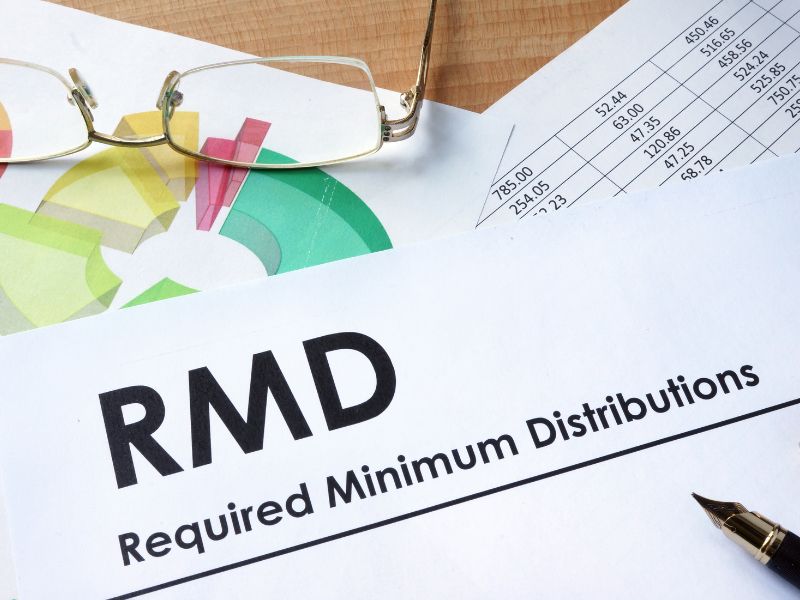These days, most people have some sort of pretax retirement plan, e.g., IRA, 401k, SEP, SIMPLE, 403b, etc. While it’s a good idea to contribute to these plans before retirement, not everyone knows what is required in retirement. Once you turn 73 years old (as of 2023) you must start taking a Required Minimum Distribution (RMD) from your qualified retirement accounts, which is the minimum amount you are required to take out of your accounts by the end of each calendar year. If you fail to take out the full RMD amount for any year, you’ll face a penalty of 25% (it used to be 50% before the Secure Act 2.0, 2023) of the amount that you didn’t pull out.
You may delay taking your RMD from a retirement plan (not an IRA) if you meet all the following:
• You’re still working (past age 73)
• You do not own more than 5% of the business for which you work
• You have an employer-sponsored retirement plan at your current job
If you meet the above criteria, you may delay taking your RMD until April 1st of the year after you retire. Keep in mind that this exception is only for the money in your active qualified retirement plan (for your current job). You will still need to take RMDs out of previous retirement plans. Each type of account has this requirement, i.e., a distribution from a previous IRA cannot satisfy a requirement for a previous 401k plan.
The good news is the IRS doesn’t care how you take the money out as long as it comes out by the end of the year. There are different strategies on how to take these distributions. Below are a couple of the most popular methods.
Once you’re retired you may find social security, pensions, or other investments aren’t giving you the income that you need to meet your monthly expenses. If that’s the case, you might use a monthly withdrawal from your IRA to boost your income. If you are required to take distributions, this takes care of two things: (1) It helps supplement your income and helps satisfy the RMD for your IRA, and (2) It’s also a good way to dollar cost average out of the market as opposed to taking your RMD as a lump sum. For example, if you pulled out your RMD in a lump sum when the market is down one month, and then the next month the market rebounds, you may not be happy with your short-term timing. By pulling out your RMD over time, it can reduce your market risk by spreading out your distributions. This method may not have a material impact due to the short time horizon, especially if you reinvest the RMD. It also may allow you to reduce what you are pulling out from non-retirement accounts.
Another popular method is utilized for people who don’t need the extra monthly income. For clients like this, we usually recommend reinvesting their RMD into a taxable account like an individual TOD (Transfer on Death), Joint account, or Trust account. Since you’re reinvesting, you could take it as a lump sum without missing out on future market returns. Just because you must take money out of your retirement plan doesn’t mean you have to spend it. In practice, because RMD amounts increase annually as you get older, we sometimes recommend a combination of a monthly withdrawal and a partial reinvestment. How you take out the RMD is based on your expenses and how much money you need to pull from your account to supplement your income. Additionally, you may find yourself in a situation where your income is stable without pulling money from your investment, but then need to redo a bathroom, fix up a deck, or some other large expense. If there is a need, you should consider using your RMD to pay for it in lieu of using cash reserves, since the funds are required to be withdrawn.
The way RMDs are calculated is relatively simple. You take the balance of the account as of December 31st of the previous year and divide that number by a factor (from an IRS table based on your age they call the Uniform Table) and the result is your RMD amount. As you age, the number of years remaining gets lower, which will increase your distribution amount every year. There are some exceptions to that, for instance, last year (2022) when the market was down considerably, which will make RMDs for this year (2023) lower.
There is one other way to calculate your RMD as well. This only applies to those who have a spouse that is more than ten years younger than the IRA owner and who is the sole primary beneficiary on the account. If that’s the case, you still take the year-end value and divide it by a factor, but the factor is not from the same IRS table. It’s from a table that the IRS calls the Joint Life Table. This table considers your age and your spouse’s age. This generally results in lower RMD amounts than the traditional method.
There used to be another situation that dealt with inheriting an IRA (2019 and prior), but the rules have recently changed if you are not a spouse of the deceased. Now, if you inherit an IRA, instead of calculating and taking an annual RMD, you have to completely deplete the account by years end of the 10th anniversary of the original owner’s death. As an example, if you inherited your mother’s IRA last year, you would have to take all the funds out by December 31st, 2032. Remember though, just because you must pull the funds out doesn’t mean you need to spend them. You can still reinvest all or a portion into a taxable account. It’s a great way to continue growing your wealth. We can assist in developing a strategy for pulling these funds out.
You might be asking, “What if I am a spouse and I am inheriting my husband’s or wife’s IRA?” In that case, if you were the sole beneficiary, you would be able to treat the account as your own. That means you would be able to roll it into an existing IRA in your name or if you don’t have an IRA, you could create one and move the inherited funds into it. If you were of RMD age, you would take a one-time RMD for the year of death of your spouse, then continue to take annual RMDs from your IRA as usual. If you are under 73 years old, then you would need only to take the year of death RMD for your husband/wife and then no other required distributions until you reach the RMD age.
RMDs can sound daunting, especially if you are not familiar with the basics of how they work. We help simplify the process and make it flexible to fit your needs. I hope you now have a better grasp of RMDs and how to approach them. The rules continually change, and we will update you as they are implemented into law.




